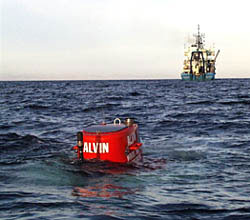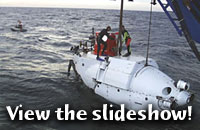|
|
Hot
Topics: What Is It Like To Go Down In Alvin?
It's like being Galileo, Jacques Cousteau, and Captain Nemo (the captain
of Jules Verne’s submarine Nautilus in Twenty Thousand
Leagues Under the Sea) all wrapped up in one. You are an inventor,
explorer, and scientist. Let's go down together!
Getting
In
It is time to leave!! You climb the stairs on the side of the A-frame
to the top of Alvin.
You are excited but slightly nervous at the thought of what you are
about to do. You remove your shoes and stow them in the bag at the
top of the steps. You climb down a narrow ladder through Alvin’s
hatch, trying not to step on the head and arms of the pilot who is
finishing his final checks of all the submersible’s systems.
You sit down on the floor of the pressure sphere, which is only two
meters (six feet) in diameter, then crouch to one side of the sphere
so the other scientist can get in.
The Alvin crew
has already stowed your bag containing warm clothes and a notebook in the side
of the sphere where you will be sitting. Even more important, the galley has
packed a lunch for everyone. It includes sandwiches, fruit, water, coffee, and
maybe a chocolate bar!. The pilot radios the Top Lab Control and the Atlantis bridge
to say: “Closing the hatch”. From this point on, you are a self-contained
little probe set to explore the seafloor.
Here
We Go!
The A-frame lifts Alvin off the deck of the ship. Suddenly you are over
open water. The A-frame stops. You hear the main lift line winch grumbling. Slowly
you descend. Ten seconds later, you splash down. Water gurgles over the view
ports. You see the swimmers working on the outside of the submarine, checking
everything before it dives. Inside, it is a little warm, but you've been told
it will get cooler as you descend. It is noisy due to the whirring of motors
and the scrubber. The scrubber is a blower that forces the air you are breathing
through a filter containing soda-lime. The soda-lime absorbs carbon dioxide so
that the air in Alvin is good to breathe.
The submarine gently rolls in the calm water as the pilot picks
up the CB microphone. “Atlantis,
this is Alvin. ID light is on. All leaks, dumps, and grounds normal.
Scrubber is scrubbing. Oxygen is on. Request launch altitude and permission
to dive.” A
few seconds later, the reply comes back. “Alvin, this is Atlantis.
Launch altitude 2005 meters. You have permission to dive.” The pilot replies: “Roger, Atlantis. Alvin diving.”
Into The Abyss
Ten minutes later, you notice that it is getting dark outside the
view port. At about 400 meters depth (1312 feet), so little sunlight
penetrates down that the water appears pitch black. You have just
passed below the photic zone and are now entering the deep dark
ocean. It’s getting cold, so you put on
your sweatshirt, sweatpants and wool socks while trying not to kick the other
observer or the pilot. The pilot tells you to look out the view port. You put
your nose up to the plastic. Suddenly you see a burst of light and what appears
to be a long string of slimy stuff slipping out of view. The middle part of
the ocean contains tons of life, much of it gelatinous, and some
of it bioluminescent. One of these animals has just spattered against
your view port. All the flickering lights of the animals remind
you that you've entered a place where many animals live but where
few people have seen.
Two hours pass by. The pilot informs you that you are only two
hundred meters from the bottom and that you should get ready. You
pull on your ski cap, ready your pens and tape recorder, and review
the dive plan with your partner and the pilot. The pilot asks you
to keep an eye out for the bottom. “Bottom in
sight,” the other observer calls. The pilot releases two of the 208-pound
descent weights and adjusts the buoyancy until Alvin “floats” just
above the seafloor. All is ready for another exciting day of science and exploration
on the ocean floor.
Back to Main Hot Topics
Page
|


